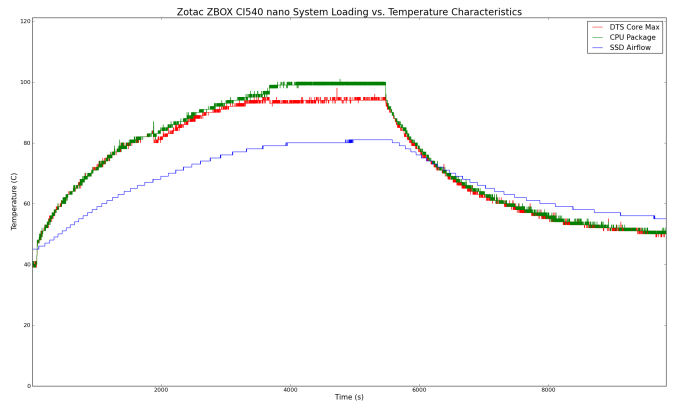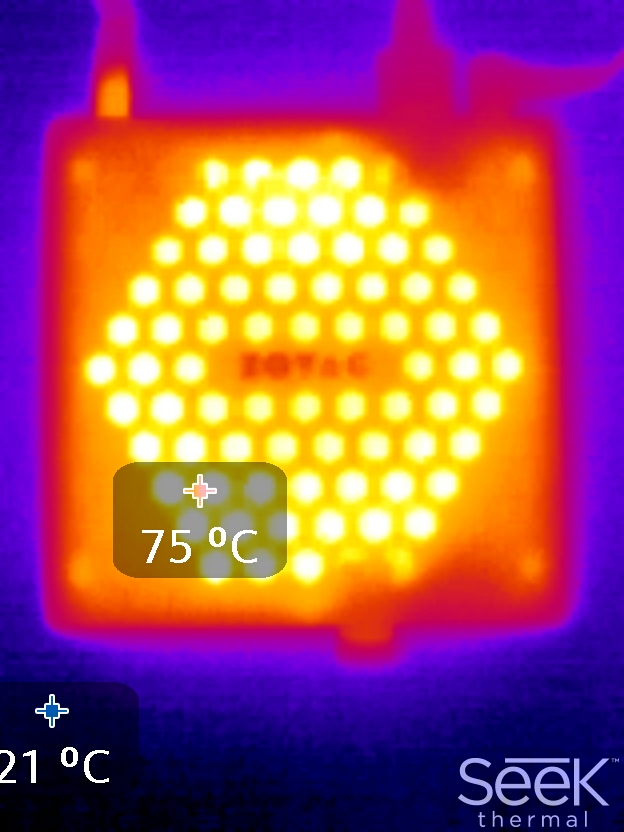Zotac ZBOX CI540 nano Review: A Fanless Haswell-Y mini-PC
by Ganesh T S on October 31, 2014 11:00 AM ESTPower Consumption & Thermal Performance
The power consumption at the wall was measured with a 1080p display being driven through the HDMI port. In the graphs below, we compare the idle and load power of the Zotac ZBOX CI540 nano with other low power PCs evaluated before. For load power consumption, we ran Furmark 1.12.0 and Prime95 v27.9 together. The numbers are not beyond the realm of reason for the combination of hardware components in the machine.


As expected, the load power consumption tracks the inherent capabilities of the CPU in the system. The Haswell Y-series CPU is more powerful compared to any of the Bay Trail parts that we have seen in mini-PCs before. But, it doesn't beat the ULV ones in the NUC-type machines. We did expect better idle power consumption numbers because of the fanless nature, but Zotac can probably optimize the BIOS a bit to drive this number further down.
While we didn't tear down the system to expose the actual thermal design, FanlessTech does have some pictures of the internals. We evaluated the thermal performance from a system perspective. We start with the system at idle, followed by 30 minutes of pure CPU loading. This is followed by another 30 minutes of both CPU and GPU being loaded simultaneously. After this, the CPU load was removed, allowing the GPU to be loaded alone for another 30 minutes. The various clocks in the system as well as the temperatures within the unit are presented below.
Under pure CPU loading, the core clocks maintain their 1.5 GHz+ speed. However, the addition of the GPU load brings down these clocks further while the system tries to keep itself within the SDP limits. Note that thermal throttling isn't at play here (as the graph below shows). After removal of the CPU load, there is some leeway for the GPU to raise its clocks. However, the CPU clock remains at the specified value instead of winding down (that happens in the idle case, where the CPU can go as low as 600 MHz).
An important point to note is that the DTS never falls to 0. This implies that there is no thermal throttling at play. That said, the Y-series CPU seems to have some internal controls where the clocks are automatically adjusted depending on the workload (to remain within the SDP limitations) even though the core temperatures is not close to the junction temperature.
Another important aspect to keep note of while evaluating fanless PCs is the chassis temperature. Using Seek Thermal's thermal imager, we observed the chassis temperature after the CPU package temperature / DTS reached the steady state value in the above graph.
The gallery below presents some of other thermal images of the unit captured under the above conditions.
75 C for the chassis temperature is pretty hot, but keep in mind that this was after subjecting the unit to power viruses - Prime95 and FurMark are hardly the expected use-cases for these types of systems.


















48 Comments
View All Comments
MadMan007 - Friday, October 31, 2014 - link
Please disassemble and see if the plastic is in place on the thermal pad or not. Since this seems to be a retail unit and not a pre-production sample, it could help to answer the question posed on those links and verify that it is not a production unit issue.Also, while the relatively higher idle power draw could be fixed, when we're talking a difference of 2-4W it's not really that big a deal in absolute terms.
noelbonner - Tuesday, November 11, 2014 - link
Why don't people get a "real" mini-PC instead (such as they ones that are rated highly at http://tinyurl.com/obzllgb for example)?BinaryTB - Friday, October 31, 2014 - link
An IR port would have been nice, for use with remotes and such, but an external usb adapter is usually the only option these days it looks like.Also, would Steam In-Home Streaming benchmarks be worth testing on these devices? I know I use my HTPC sometimes in my living while my gaming desktop is elsewhere in the house (both devices on gigabit ethernet and nvidia hardware encoding on the host and intel hw decoding on the htpc client). Latency and such would be a good measure, assuming it would vary statistically for each device.
nathanddrews - Friday, October 31, 2014 - link
The external IR will probably be your only option for he foreseeable future. Newer HT gear can usually be networked and controlled via apps or browser sessions. Steam IHS is pretty solid even on wireless Atom devices, so it's probably pointless to review on an i5 with GbE. I'm with you, though, and would like to see a proper review of the IHS feature someday.meacupla - Saturday, November 1, 2014 - link
IR is so outdated.BT remote should be standard already.
Alexvrb - Sunday, November 2, 2014 - link
IR works and is probably the lowest power option there is. The less often I have to change remote batteries, the better.cjb110 - Monday, November 3, 2014 - link
Unless you want to use a universal remote...IR works and is lower power...the only advantage BT offers is less reliance on Line of Sight.BuddyRich - Monday, November 3, 2014 - link
IR is good for learning but if line of sight is a concern get an RF -> IR blaster and a remote that supports both IR and RF, some Harmony's, URCs, Philips do.jmorey - Monday, November 3, 2014 - link
Zotec says it has an integrated IR receiver and visually it appears that it does (see the transparent black plastic area between the WiFi LED and the memory card reader slot). Can someone confirm that? It is a required feature for me as I already have Harmony remotes that are IR only.josue16 - Friday, October 31, 2014 - link
Is this the only fanless pre-built Haswell based UCFF PC available?